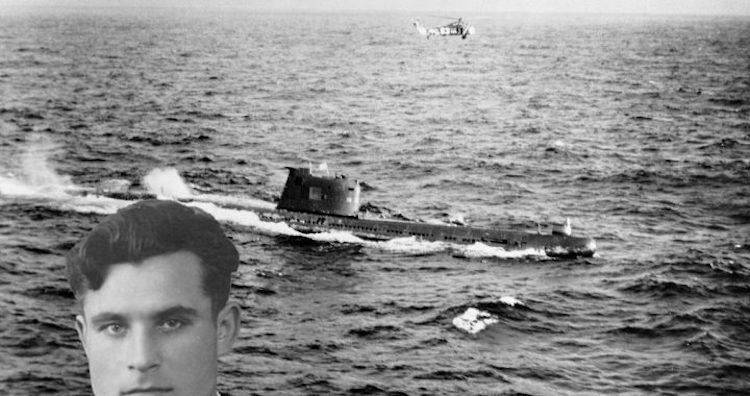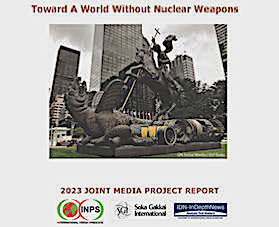By Glen Milner and Leonard Eiger
The man who saved the world from thermonuclear annihilation in 1962 was born on January 30, 1926. Ground Zero Center published this article.
POULSBO | WASHINGTON, USA (IDN) — At a time when the probability of nuclear war is as nearly as high as it was during the Cuban Missile Crisis, it is crucial that we recall the story of Vasili Arkhipov, a Soviet submarine officer who prevented a Soviet nuclear strike against U.S. surface warships during that very crisis in 1962. [2023-01-30]
An attack by a single Soviet submarine using just one nuclear-armed weapon would have caused a major global thermonuclear response.
In the fall of 1962, Soviet Premier Nikita Khrushchev secretly began the deployment of medium and intermediate-range ballistic nuclear missiles in Cuba. On October 22, 1962, President John Kennedy ordered U.S. naval forces to enforce a naval “quarantine” of offensive military cargoes en route to Cuba. On the same day, CIA Director John McCone informed President Kennedy that four Soviet submarines were positioned to reach Cuba within a week.
All four Soviet diesel-powered Foxtrot-class submarines in the flotilla were equipped with conventional torpedoes and one “Special Weapon”—a torpedo equipped with a 15-kiloton nuclear warhead. Soviet officers were told that in the absence of the possibility of communication with Moscow, only the agreement of the captain of the submarine and the political officer were needed to launch a nuclear torpedo. But on submarine B-59, due to Arkhipov’s position as chief of staff of the flotilla, all three officers on board B-59 had to agree unanimously to authorize a nuclear launch.
On October 27, 1962, a group of eleven U.S. Navy destroyers and the aircraft carrier USS Randolph located Soviet submarine B-59 near Cuba. Despite being in international waters, the U.S. Navy started dropping signaling depth charges, explosives intended to force the submarine to come to the surface for identification.
At this time, the Soviet crew had been out of contact with Moscow for several days and the submarine was too deep to monitor U.S. civilian radio broadcasts. The submarine’s batteries had run very low and the air conditioning had failed, causing extreme heat and high levels of carbon dioxide inside the submarine.
Under these extreme conditions, the captain of the submarine, Valentin Savitsky, decided a war might have already started. As the depth charges exploded around his vessel, Captain Savitsky ordered the arming of the nuclear torpedo and came within minutes of launching it.
According to a Soviet intelligence report, an argument broke out on B-59, with Arkhipov alone blocking the launch. Arkhipov eventually persuaded Captain Savitsky to surface amid U.S. Navy vessels and await orders from Moscow.
No one on the U.S. side knew at the time that the Soviet submarines were nuclear-armed; no one knew that conditions in the submarines were so physically difficult and unstable that commanding officers, fearing they were under attack by U.S. forces, might consider arming and launching their nuclear torpedoes.
On November 2, 1962, Kennedy addressed the nation regarding the dismantling of the Soviet nuclear missile bases located in Cuba. All Soviet nuclear weapons were removed in the following months.
Strangely, many historians view the Cuban Missile Crisis as a triumph of rational leadership in both the Soviet Union and the United States. However, it was the leadership in both countries that brought the world to the brink of annihilation in the first place—only to be prevented by a single Soviet naval officer.
Ultimately, Kennedy and Khrushchev did negotiate in good faith to end the stalemate, with Kennedy agreeing to withdraw US nuclear-armed missiles from Turkey in exchange for the Soviets withdrawing their missiles from Cuba. Yet, had Arkhipov not prevented the launching of a single nuclear-armed torpedo against a US warship, the two leaders would not have had the chance to bring the crisis to a peaceful resolution.
Today, in the United States, hundreds of individuals have the awesome responsibility to launch nuclear weapons on the command of a verified authority in our government. In the case of any of the OHIO Class “Trident” ballistic missile submarines, up to ten of which might be on patrol at any given time, it is a possibility, even though a remote one, that one or more submarines would be unable to receive communications during a crisis involving Russia.
In such a situation the anxious officers might question whether or not to launch their 20 Trident II D-5 ballistic missiles, each armed with an average of 4-5 thermonuclear warheads—the total equivalent destructive force of over 1,200 Hiroshima bombs.
In such a situation we could only hope that those officers would reflect on Arkhipov’s courageous act before deciding to initiate the launch sequence that, should a nuclear war have not already started, would certainly trigger the conflagration that would end civilization as we know it.
Considering the current crisis in Ukraine—Russia’s ongoing nuclear rhetoric, NATO’s encirclement of and pressure on Russia, the increasingly dangerous escalation in weaponry provided to Ukraine by the US and allies, and the high probability of tactical miscalculations—the probability of either accidental or intentional use of nuclear weapons cannot, and must not, be discounted.
Cooler heads must prevail to save humanity from annihilation, and the importance of Arkhipov’s actions are therefore more important than ever before.
January 30 would have been Vasili Arkhipov’s 97th birthday: he retired as a Vice Admiral in the mid-1980s; and died on August 19, 1998.
May we, as citizens of the world, demand that the nuclear-armed nations pull back from the brink, and work together toward the day when nuclear weapons will be only a memory, putting our human and economic capital into mutual cooperation to preserve our world for the sake of future generations. [IDN-InDepthNews – 30 January 2023]
Image: Vasili Arkhipov and Soviet submarine B-59, forced to the surface by U.S. Naval forces in the Caribbean near Cuba, with a U.S. helicopter overhead. Source: U.S. National Archives.













